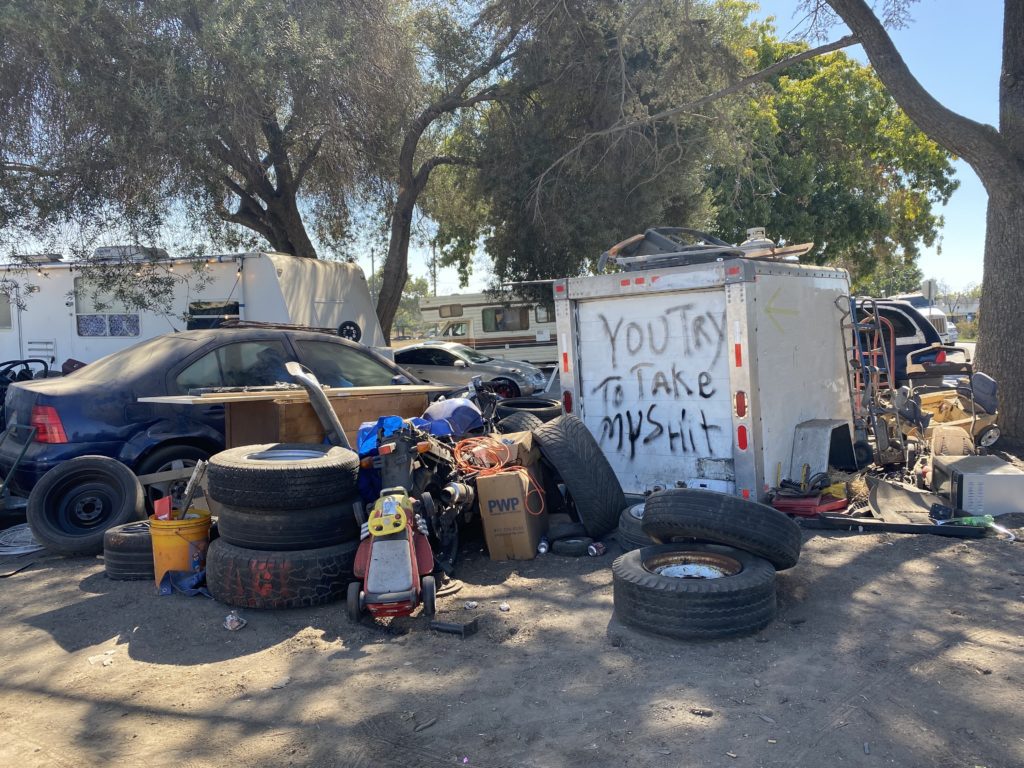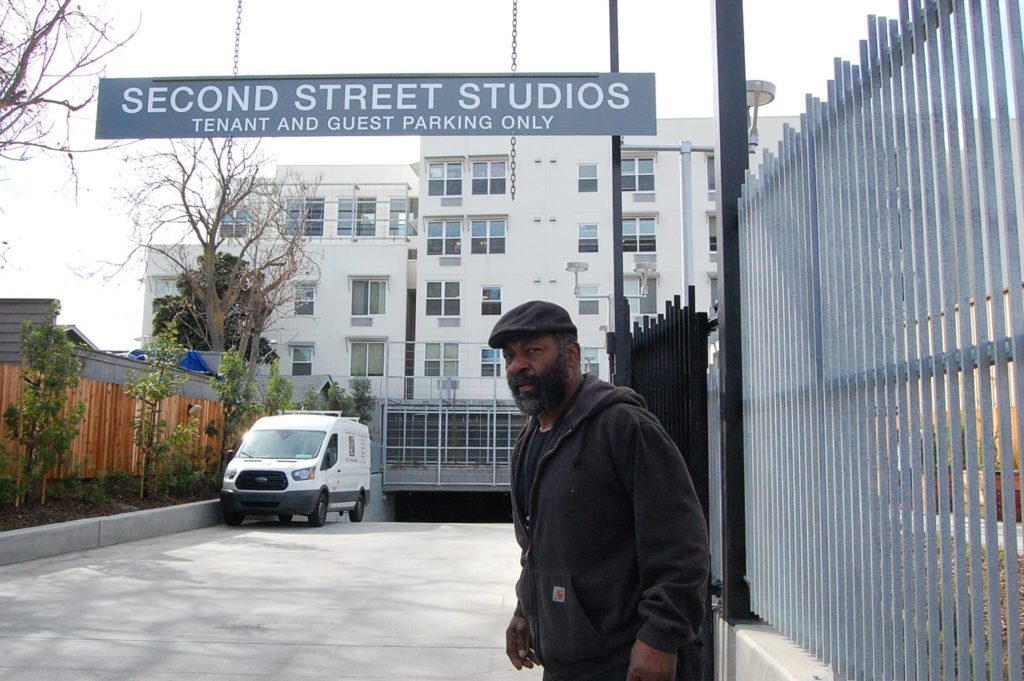Despite decades of robust efforts and hundreds of millions of dollars spent, San Jose’s homelessness crisis continues to grow—leaving residents, officials and advocates frustrated.
For some unhoused residents in Columbus Park, the largest encampment in San Jose, the solution to their problem is simple: Give them housing.
“Everybody out here wants to live in a home,” said Steve, who has lived on the streets of San Jose for 31 years and didn’t provide his last name. “Who wouldn’t?”
Politicians and housing activists agree with Steve: Housing is the key to solving the crisis. How to get there, however, is complicated.
“If anyone had a silver bullet, they would have solved it by now,” Councilmember Sergio Jimenez told San José Spotlight. “It’s challenging.”
A growing crisis
The number of unhoused residents in San Jose has exploded over the last few years. In 2019, the number hit close to 7,000 people. No one knows for sure how many more people have been pushed onto the streets in the last two years because the county canceled its biennial homeless count in January citing COVID-19 concerns. But advocates say more people are living along the creek, under bridges and in city parks than ever before — a problem exacerbated by COVID-19.
“Every time we went out to camps, it would be like, ‘Who are these people?,'” said homeless advocate Shaunn Cartwright. “There was always new people during COVID.”


As homelessness skyrockets, tensions between homeowners and the unhoused population are at an all-time high. More than 1,000 people signed a petition to kill a plan to allow homeless people — who were swept off Apple’s vacant property in North San Jose — to sleep in their cars at a city-sanctioned site. At another encampment in South San Jose, someone sent fake police notices last month to frighten homeless people into leaving. Nearby homeowners were the suspected culprits.
The crisis is fueled by the high cost-of-living and skyrocketing rents. San Jose is the second most expensive place to rent in the nation, according to new estimates. There are only 34 affordable and available housing units per 100 extremely low-income households in Santa Clara County.
Officials can’t keep up. For every person that’s housed, nonprofit leaders say two more become homeless.
“The challenge that we have is due to the lack of affordable housing, (and) the lack of political will to create enough affordable housing,” Jennifer Loving, CEO of Destination: Home, told San José Spotlight. “We continue to have people becoming homeless year over year.”
Loving added that lawmakers need to muster the political will to adopt policies that increase housing density, such as Opportunity Housing, which allows building up to four new units on land zoned for single-family homes.
“For every councilmember who was saying that we have a homelessness crisis, why are they not being aggressive in building affordable housing in their districts?” Loving said. “We are unwilling to change our zoning to build more housing.”
Severe housing shortages
Despite its commitment to build 10,000 affordable homes by 2023, San Jose is lagging far behind. As of this year, the city has completed 506 affordable units since 2018. Santa Clara County is also behind on its affordable housing goal of 4,800 units, a recent audit found.
The reasons: Building costs are too high, land is scarce and it takes too long, government officials have lamented. According to Mayor Sam Liccardo during a panel in May, it costs roughly $800,000 to build a permanent housing unit.
“If there is one hurdle that is particularly challenging in our area, it is the cost of land and labor,” said Jeff Scott, spokesperson for the San Jose housing department. “We have to get creative when it comes to finding places to build affordable housing.”
The city says it will continue to address inequality that leads people to homelessness by expanding safety net programs, adopting a living wage in the city, among other initiatives.
San Jose last year adopted a three-prong plan that serves as a guideline for how it attacks the homelessness crisis. The plan outlines how to address the disparity that affects people of color disproportionately and homelessness prevention.
“You don’t reverse 50 years of growing income inequality, wages, not building deeply affordable housing, systemic racism in a minute,” Loving said. “It takes time.”
What’s been done
Six years ago, Santa Clara County, San Jose and local organizations, such as Destination: Home and LifeMoves, began working together to tackle the crisis, Loving said.
“We all said that we needed to focus on ending homelessness versus just managing it and everybody wants to work together, which seems obvious,” she said. “But until that time, that wasn’t what was happening.”
More than 14,000 people received housing in the first five years of the partnership, according to Scott.


In 2020, the city opened Second Street Studios after months of delay. The downtown complex housed some of the most vulnerable, chronically homeless and disabled people in the region.
Public-private partnerships with Silicon Valley tech giants have become more common in the past few years. Housing Trust Silicon Valley has raised $117 million from Cisco, Google, LinkedIn, among others through its TECH fund for affordable housing since 2017.
This week, San Jose and Santa Clara County officials unveiled a new partnership with the Immanuel Evangelical Lutheran Church of San Jose to build 108 units of affordable housing on the church’s vacant lot on Moorpark Avenue. It is the city’s first time using a place of worship to house homeless residents.
When the COVID-19 pandemic hit, Destination: Home led a cash assistance program that distributed more than $50 million to help 17,000 households. Roughly 4,800 people got off the streets, Loving said.
The city, using state and federal funds, also put up a little more than 1,000 people in motels during the pandemic.
“This gave them some extra space or some time, so they don’t need to be on the street,” Jimenez said.
San Jose is home to five interim housing sites — on Maybury Road, Felipe Avenue, and three emergency sites built during the COVID-19 pandemic on Bernal Road, Evans Lane, and at Rue Ferrari and 101. Some are tiny homes, while others are modular or prefabricated homes.
The city bypassed lengthy regulatory steps under a COVID-19 emergency declaration to build the three emergency interim housing communities with more than 300 beds.


City officials estimate these projects are much faster and cheaper to build—at $85,000 per unit. But the rush to get the units built presented some new challenges: At least one of these projects was plagued with violations like wage theft and safety hazards.
“I’m not saying it’s good enough,” Loving said. “But when people say nothing’s working, that is factually inaccurate. When people say nothing’s being done, that is factually inaccurate.”
More work to be done
But there are still many solutions San Jose has not tried.
The council in May unanimously rejected plans to establish a sanctioned encampment, despite pleas from advocates. Few councilmembers wanted to host a legalized homeless camp in their districts. And the housing department said it didn’t have the resources to run one.
Establishing safe parking sites has also been an uphill battle.
Many homeless residents say they just want a stable place to stay to maintain their independence. For some, an RV will do.
“If the city gives me that, I swear they’ll never see me out here again,” said Patricia, who grew up playing baseball at Columbus Park and now sleeps in her van with a partner across the field. She didn’t provide her last name.


Despite some progress, San Jose still falls short on delivering affordable housing to its residents. In the last three years, 14,742 market rate housing units were approved, constructed and completed—around 4.8 times more than affordable units.
“This is not a homelessness crisis, it’s a housing crisis,” Cartwright said.
Pilot programs that create interim housing could be helpful, Cartwright said, but permanent housing remains a key component in solving the crisis.
“We need our elected officials to be willing to say that (they’re) not willing to vote on pilot projects anymore and only willing to vote on large projects that will help our unhoused folks or folks that are housing insecure,” she said.
SJSU sociology professor Scott Myers-Lipton said San Jose needs to ask the tech giants in its backyard to start paying their fair share to solve an issue they’ve contributed to.
“We need rent subsidies, and we need to build massively,” he told San José Spotlight. “And don’t tell me there’s not money in this community… Our tech community is building and building more office spaces. But what about our community?”
Editor’s Note: Jennifer Loving serves on San José Spotlight’s Board of Directors.
Contact Tran Nguyen at [email protected] or follow @nguyenntrann on Twitter.



Leave a Reply
You must be logged in to post a comment.